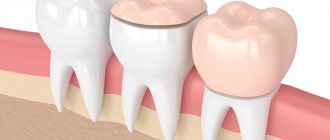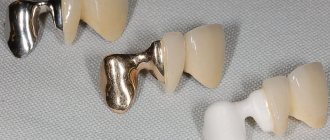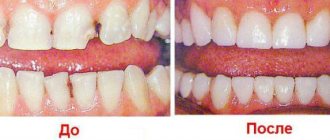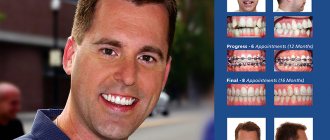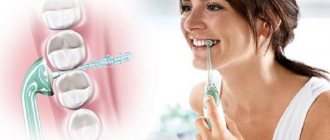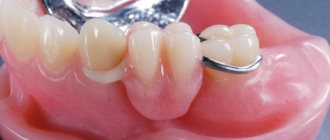Press ceramics refers to one of the types of microprosthetics, for which materials from zirconium oxide or lithium disilicate are used. A feature of such structures is their solidity.
E.max metal-free ceramics are the first all-ceramic system used in dentistry. Such compounds meet the basic requirements of this field: they are absolutely non-toxic, have high strength and an aesthetic appearance.
When it first appeared on the market, press ceramics caused a huge stir among consumers. Patients highly appreciated the dentures, which cannot be distinguished from natural teeth. Today, metal-ceramic prosthetics is practically not used in dentistry; it has been replaced by newer and more effective technology. MOSCOW DENTAL CLINIC provides dental restoration services using press ceramics. This system is characterized by high strength and durability. It does not cause allergies and prevents the growth of bacteria in the oral cavity.
Why ceramics
The term "ceramics" translated from ancient Greek means pottery clay. At the chemical level, clay is an aluminum silicate with an amorphous structure. The properties of ceramics after firing make them extremely durable, and therefore attempts to use them in dentistry began two centuries ago.
However, serious advances in the use of ceramics were achieved relatively recently and were caused by a thorough study of the chemical properties of this material. It is ceramics that has the most significant similarity in both strength and optical properties with natural teeth, which has attracted increased interest from dentists.
As a material for the manufacture of restorations such as veneers, inlays or crowns, ceramics, including
pressed ceramics , can offer the optimal combination of functionality and aesthetic characteristics.
The basis of work in the manufacture of restorations is modeling. To do this, impressions of the patient’s jaws are made, on the basis of which a wax model is created and the appearance of future restorations is formed. The finished ceramic blank is placed in a press, where the ceramic is pressed under high pressure and receives its characteristics. After this, the finished structure is placed in a kiln and fired, as a result of which it receives its finished appearance and properties.
ips e.max – scientific data
High-strength ceramic material - lithium dislicate - has a bending strength of up to 400 MPa and is ideal for the manufacture of monolithic anatomical restorations.
Data on the properties of this material and the possibilities of its use in prosthetic dentistry were obtained as a result of a complex of research activities at the American University in New York.
Thus, it was found that the unique potential of lithium dislicate ceramics (IPS e.max Press, Ivoclar Vivadent) made it possible to produce ultra-thin and minimally invasive restorations with excellent esthetic results using the pressing method.
Also read: Tooth impaction: what it is, reasons, how to treat, prevention
E Max ceramics are crowns, inlays, onlays, and veneers made of lithium disilicate.
Depending on the specific clinical situation, the dentist selects the appropriate all-ceramic material:
– in order to achieve an excellent aesthetic effect for the lateral and anterior groups of teeth when performing single restorations, it would be a good choice in favor of lithium disilicate,
– if a long-term restoration is planned, for example, bridges in the masticatory region, where increased strength is so important, a base made of zirconium oxide ips e.max is recommended.
Receiving technology
Manufacturing is carried out in several stages:
- After carefully checking the quality and purity of the mixture, called a mixture, it is placed in special containers for melting the materials.
- The mixture of components is fired until glass melt is formed.
- The resulting melt is cooled sharply, causing it to crack. This process is called fritting. It allows you to obtain a fine-crystalline powder, the constituent parts of which are thoroughly mixed.
- To color the resulting mixture, various pigments are added to it, making it possible to achieve maximum resemblance of the final material to the dental coating.
Subsequently, dental laboratory specialists use the resulting powder to make various structures: dentures, crowns, inlays.
The video shows the process of casting and pressing ceramics.
Application of E.max ceramic press
E.max ceramics are widely used in dentistry for the manufacture of various structures:
- Veneers and lumineers. Before the invention of metal-free ceramics, they were made from photopolymer materials, which have a much shorter service life. Modern press ceramic veneers are much more durable and aesthetically pleasing.
- Bridges. E.max ceramic bridges restore the aesthetics and functionality of a whole range of front teeth. A durable bridge structure can withstand heavy loads and is indistinguishable from natural teeth in appearance.
- Crowns. They are used in cases where it is not possible to preserve the tooth base by other means. Products can be made in the form of single crowns or full-fledged structures on various parts of the dentition.
- Tabs. These are minimally invasive devices that are used for partial destruction of the crown of a tooth. They are an excellent alternative to photopolymer fillings, which can wear off over time. Ceramic inlays are much stronger and more durable.
What are Empress crowns?
Firstly, it is worth saying that Empress crowns are manufactured by a German manufacturer. That is, the country of origin is Germany. German manufactured products have always been distinguished and are of excellent quality.
Empress crowns are undoubtedly a metal-free ceramic material. These crowns have become a very good new solution to metal-ceramic crowns. To increase the reliability and strength of Empress crowns, in addition to glass ceramics, leucite elements were added to them. Now we can talk about the advantages and features of Empress crowns.
Advantages of pressed ceramics
So what are the benefits of these metal-free crowns?
This is what we will try to figure out. Moreover, their very advantage comes from the name.
1. Lightness. Compared to other permanent types of crowns, a metal-free ceramic crown is the lightest. What if there is more than one crown in the mouth? The lower jaw, of course, will not sag from the weight of the metal ceramics, but still... the difference is noticeable.
2. Durability. Thanks to pressing, the strength of the ceramic has greatly increased; now it no longer needs a metal cap as a frame. Imagine two reams of paper, one of which is pressed, which one is stronger than the one that breaks?
3. Color rendition. The color of a tooth covered with a press ceramic crown is deeper and richer. It will definitely be difficult for even an experienced specialist to determine whether it is a real tooth or an artificial crown, not to mention the people around you. In short, it is better to see once than to hear constantly. The color is so rich that words cannot describe it.
4. Metal-free crowns price. Yes, and I didn’t make a mistake. Please do not compare with metal-ceramic crowns, these are completely different weight categories. But when compared in the metal-free category, in particular with zirconium dioxide, press ceramics will come out the winner.
Also read: Adhesive bridge: what is it, manufacturing process, installation and care
5. Non-invasive. To process a tooth under a ceramic press, it is necessary to grind less hard tooth tissue than for other permanent structures. The explanation is quite simple - the thickness of the crown, which we will put on the ground tooth. The more of our own hard tooth tissues we preserve, the longer it will last.
6. Versatility. Not only new crowns are made from press ceramics, but also inlays, onlays for teeth and attention - ceramic veneers .
7. Vitality. Thanks to the gentle treatment of the hard tissues of the tooth, there is no rule for depulping it. The tooth can be left alive, with the correct protocol for its preparation in order to avoid overheating of the pulp, and therefore, a living tooth will last much longer than a dead one.
8. Manufacturing. Easier and faster than other types of crowns.
And these are not all the advantages...
Among the negative aspects, it is necessary to note the impossibility of manufacturing long-term bridges and in the lateral section.
Free consultation
Our specialists will conduct a free consultation and select the best treatment option for you.
Sign up now! Online registration
+7 (495) 649-41-19
Content
1 What are Empress crowns?
2 Features of Empress crowns:
3 And now a little about how the process of creating Impress crowns occurs
4 Installation of Empress Crowns, before and after photos:
5 Prices for installing dental crowns
6 Now let's summarize
Stages
Metal-free ceramics is a modern approach to dental prosthetics, which is produced quite quickly (in 2 - 3 days).
Stages of manufacturing metal-free ceramic structures:
- Preparing teeth for prosthetics: treatment, preparation.
- Obtaining an optical impression of the prepared tooth and antagonist teeth.
- Determining the color of the future structure.
- Digital modeling of the frame of the future prosthesis.
- Turning the frame of a structure from zirconium dioxide on a milling machine.
- Applying ceramic mass to the frame. Firing in a kiln.
- Try-on in the patient's mouth.
- Fixation of metal-free ceramics with permanent cement.
Complications
After installing metal-free structures, some problems may arise:
- Color mismatch with real teeth.
- Poor marginal seal.
- Inaccurate creation of the anatomical shape of the tooth.
- The presence of pain associated with discrepancy in the size of the structure.
Complications can arise when the dental technician, when making dentures, relied only on the impression, without consulting the dentist.
With the right approach, all these complications can be easily avoided.
Ceramics price level e.max
You need to understand that prosthetics is a complex process that includes many stages, and often the work of several specialists.
Therefore, it is difficult to give an accurate estimate of the cost of what is called “turnkey” work - it will depend on many factors, the primary of which is the clinical picture. To understand what the final cost consists of, we list the main stages that affect the price of installing a restoration, such as a crown, inlay or veneer made of emax ceramics:
- Materials. This category includes not only the final structures - a ceramic veneer or an emax crown, but also auxiliary components - alginate mass for the impression, plaster and wax models, ceramics for shaping and pressing, fixing materials, retraction threads and much more. The higher the quality at each stage, the higher the price.
- Job. In the manufacture of the structure, not only an orthodontist is involved, but also junior medical staff and technicians from the best dental laboratory in Moscow. The quality of the final result depends on the qualifications of each specialist.
- Associated costs. Cost and depreciation of equipment, rental of premises, support staff, taxes. All this is an integral part of the treatment process and affects the cost.
Below are the approximate price of veneers and max that you can count on when installing orthopedic structures:
- e.max veneers - from 14,000 to 28,000 rubles;
- e.max Inlay/Onlay tabs - from 16,000 to 27,000 rubles;
- metal-free crowns e.max - from 19,000 to 29,000 rubles;
- crowns on a zirconium oxide frame - from 15,000 to 32,000 rubles.
Press ceramics - reviews
Pressed ceramics in dentistry e max is a structural material for the ideal solution to dental problems. The high tensile strength and optical characteristics illustrate the wide possibilities of this type of prosthetics.
The topic of e.max restoration is of interest to an increasing number of patients - and this is quite reasonable, since veneers, inlays, and lumineers made on the basis of metal-free ceramics are superior in all respects to materials known in dentistry.
Pressed ceramics logically require higher prices than classic metal-ceramic structures, but this does not discourage patients seeking dental restoration at the level of high European standards. Like natural teeth, press ceramics require constant care at home, but it is advisable to visit a doctor once a year for a preventive examination and use professional hygiene products on the advice of a specialist.
Reviews on dental forums in thematic sections - press ceramics, e.max - are invariably positive due to the excellent optical and physical properties.
Often patients, undecided on their choice, pay attention to the opinions of those who have already experienced the process of dental prosthetics, and are also interested in the point of view of experienced specialists.
It should be noted that e max ceramics has achieved success and recognition, securing high performance in practice, but the indications for its use are individual, so it is especially important to clarify in advance all the nuances of prosthetics, the price scale, indications and contraindications, and then make a decision taking into account medical advice.
Veneer care
Veneers of any variety, be it ceramic, porcelain, or others, require the same care as natural teeth. But there are additional recommendations for maintaining the aesthetic appearance and extending the service life of the onlays, namely: reducing the consumption of food with dyes, as there is a risk that the bonding cement may change its shade; do not expose teeth with onlays to increased stress to avoid peeling off or damaging the onlays and conduct preventive examinations at a dental clinic every six months.
